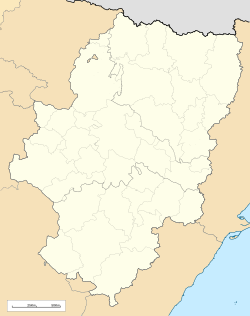Fórnoles facts for kids
Quick facts for kids
Fórnoles/Fórnols de Matarranya
|
|
|---|---|
| Country | Spain |
| Autonomous community | Aragon |
| Province | Teruel |
| Area | |
| • Total | 32 km2 (12 sq mi) |
| Population
(2018)
|
|
| • Total | 75 |
| • Density | 2.34/km2 (6.07/sq mi) |
| Time zone | UTC+1 (CET) |
| • Summer (DST) | UTC+2 (CEST) |
Fórnoles, also known as Fórnols de Matarranya, is a small town in Spain. It is located in the province of Teruel, which is part of the Aragon region. This town is found within a special area called the Matarraña/Matarranya comarca. In 2018, about 75 people lived in Fórnoles.
Contents
Where is Fórnoles Located?
Fórnoles is situated in the eastern part of Spain. It's in the province of Teruel, which is known for its beautiful natural areas. The town is part of the Matarraña/Matarranya comarca, a region that shares its name with a river. This area is famous for its charming villages and lovely landscapes.
Understanding a Municipality
A municipality is like a local government area. It's a town or a small city, along with the land around it. Fórnoles is a municipality, meaning it has its own local government to manage things like roads and public services for its residents.
Population and Community
Fórnoles is a very small community. In 2018, only 75 people lived there. This means it's a quiet place where people likely know each other well. Small towns often have a strong sense of community.
Life in a Small Spanish Town
Life in a small Spanish town like Fórnoles can be very peaceful. Residents might enjoy the quiet surroundings and the natural beauty of the Matarraña/Matarranya region. Many small towns in Spain keep old traditions alive.
Geography of the Region
Fórnoles covers an area of about 32 square kilometers. It is located in a part of Spain that has diverse landscapes. The Matarraña/Matarranya comarca is known for its hills, forests, and rivers. This makes it a great place for outdoor activities.
Natural Surroundings
The area around Fórnoles is rich in nature. You might find olive groves and almond trees, which are common in this part of Spain. The natural environment provides a home for various plants and animals.
See also
 In Spanish: Fórnoles para niños
In Spanish: Fórnoles para niños



